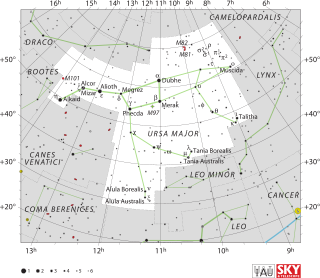Delta Ursae Majoris
| Observation data Epoch J2000 Equinox J2000 |
|
|---|---|
| Constellation | Ursa Major |
| Right ascension | 12h 15m 25.56063s |
| Declination | +57° 01′ 57.4156″ |
| Apparent magnitude (V) | +3.312 |
| Characteristics | |
| Spectral type | A3 V |
| U−B color index | +0.067 |
| B−V color index | +0.075 |
| Astrometry | |
| Radial velocity (Rv) | -20.2 km/s |
| Proper motion (μ) |
RA: +143.42 mas/yr Dec.: -129.88 mas/yr |
| Parallax (π) | 55.82 ± 0.25mas |
| Distance | 58.4 ± 0.3 ly (17.91 ± 0.08 pc) |
| Details | |
| Mass | 1.63 M☉ |
| Radius | 1.4 R☉ |
| Luminosity | 14 L☉ |
| Surface gravity (log g) | 4.49 cgs |
| Temperature | 9,480 ± 570 K |
| Rotational velocity (v sin i) | 233 km/s |
| Age | 0.3 Gyr |
| Other designations | |
| Database references | |
| SIMBAD | data |
Delta Ursae Majoris (δ Ursae Majoris, abbreviated Delta UMa, δ UMa), also named Megrez, is a star in the northern circumpolar constellation of Ursa Major. With an apparent magnitude of +3.3, it is the dimmest of the seven stars in the Big Dipper asterism. Parallax measurements yield a distance estimate of 58.4 light-years (17.9 parsecs) from the Sun.
Megrez has 63% more mass then the Sun and is about 1.4 times its radius. It has a stellar classification of A3 V, which means it is an A-type main sequence star that is generating energy at its core through the nuclear fusion of hydrogen. It shines at 14 times the luminosity of the Sun, with this energy being emitted from its outer envelope at an effective temperature of 9,480 K. This gives it the white hue typical of an A-type star.
This star has an excess emission of infrared radiation, indicating the presence of circumstellar matter. This forms a debris disk around an orbital radius of 16 Astronomical Units from the star. This radius is unusually small for the estimated age of the disk, which may be explained by drag from the Poynting–Robertson effect causing the dust to spiral inward.
It has two faint companions, a 10th magnitude star and an 11th magnitude star, both at an angular separation of two arcminutes from the primary.
...
Wikipedia

